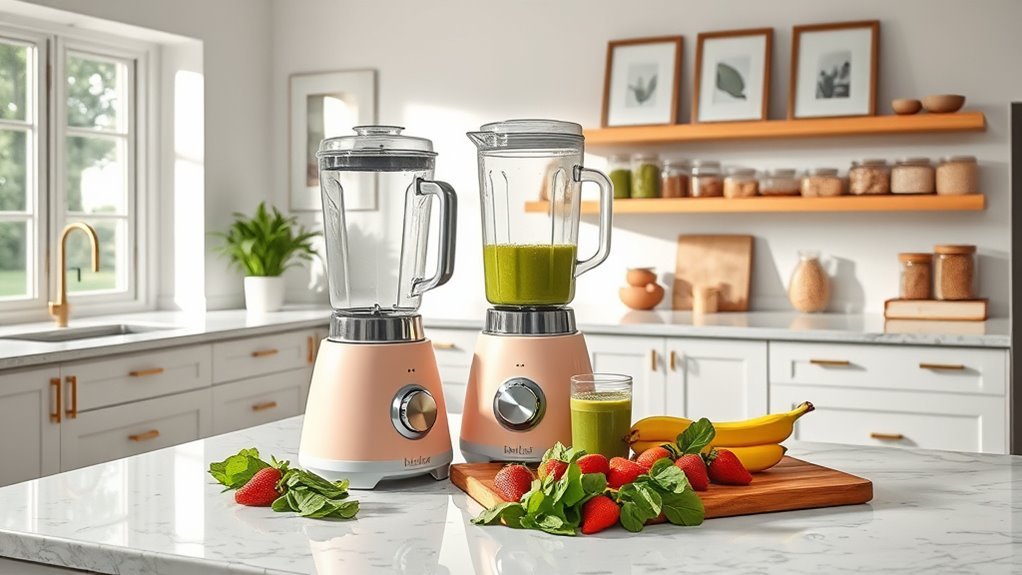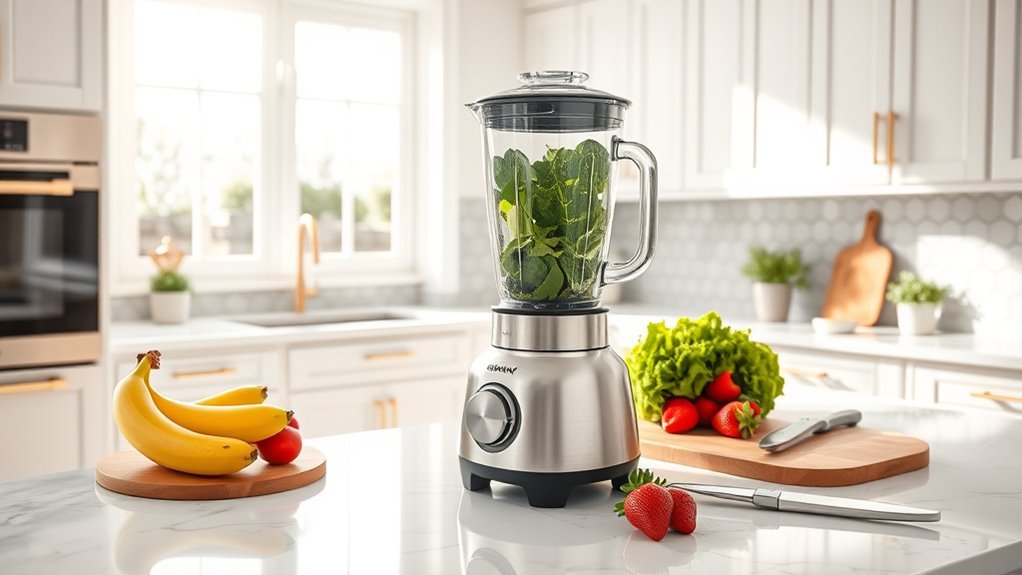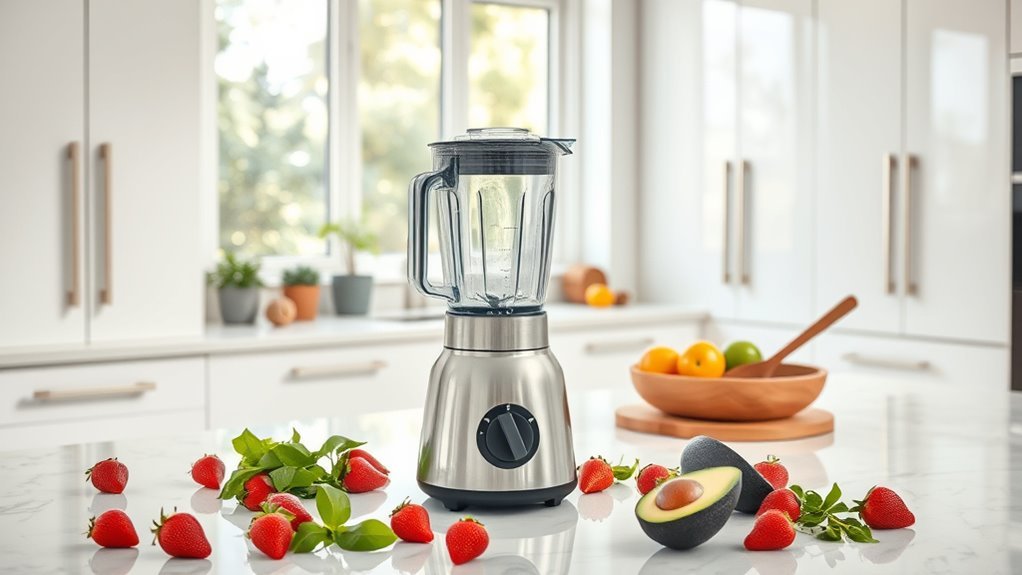We’ve found five game-changing solutions for dull blender blades that’ll restore peak performance. Professional-grade replacements with 7-fin designs offer commercial quality at home prices, while DIY sharpening with 600-grit sandpaper can revive existing blades. Aftermarket options slash costs by 40-60%, though original manufacturer blades guarantee ideal fit. Monthly maintenance and proper cleaning extend longevity greatly. The right blade upgrade transforms your everyday blender into a professional-grade powerhouse.
Understanding Blade Wear and Performance Impact

A dull blender blade isn’t just an annoyance – it’s a performance killer that’s probably destroying your appliance right now.
We’re seeing blenders work twice as hard to achieve half the results, putting massive strain on motors that weren’t designed for such abuse.
Let’s get real about what’s happening in your blender. Those worn-down edges aren’t just making your smoothies chunky – they’re forcing your machine to run longer, heat up faster, and die younger.
When blades lose their edge, you’re looking at uneven mixing, stubborn ice chunks, and grainy purees.
Don’t wait until your motor burns out. A quality replacement blade does more than restore performance – it transforms your aging blender into a high-efficiency workhorse that actually delivers the smooth, consistent results you paid for. Investing in a high-performance blender can help achieve a more nutrient-rich diet by breaking down food more effectively.
Professional-Grade Replacement Blade Options
Professional-grade replacement blades represent the gold standard for bringing new life to tired blenders, delivering commercial-quality performance at a fraction of the cost.
We’re seeing remarkable advances in blade engineering, with materials and designs that tackle even the toughest ingredients head-on.
Let’s cut to the chase: these high-performance blades aren’t just sharper – they’re smarter.
With features like 7-fin designs and BPA-free construction, they’re specifically engineered to prevent leaks while maximizing blending efficiency.
We’re talking about blades that slash through ice and fibrous vegetables like butter, reducing your prep time considerably.
The investment pays off: professional-grade blades maintain their edge longer and can dramatically extend your blender’s lifespan.
It’s simple math – better blades equal better results, especially when paired with high-performance blenders that maximize their potential.
DIY Blade Sharpening Techniques and Tools

While professional replacement blades deliver premium results, smart DIY sharpening can breathe new life into your existing blades at minimal cost.
We’ve found that 600-grit silicon carbide sandpaper mounted on a Popsicle stick creates the perfect sharpening tool for dull blender blades.
Let’s get those blades razor-sharp: Remove the blade assembly, then draw the sandpaper across each edge in one direction.
Watch that bevel angle – it’s essential for ideal results. A few strokes might do the trick for minor dullness, but don’t skimp if they’re seriously worn.
Here’s the non-negotiable part: thoroughly clean off those metal filings before reassembly.
And hey, before you get started, check replacement blade prices – sometimes a few bucks for new ones beats the DIY route.
Aftermarket Vs Original Manufacturer Blades
Making the right blade choice means understanding the trade-offs between aftermarket and original manufacturer options – it’s not just about price.
We’ve analyzed countless aftermarket blades against originals, and here’s what matters: compatibility, performance, and long-term value.
- Aftermarket blades slash costs by 40-60%, but warranties rarely match manufacturer guarantees.
- Original blades deliver ideal fit and peak performance, especially for specialized models.
- User experiences with aftermarket options vary wildly – from perfect matches to total failures.
- Installation compatibility requires careful verification, particularly with unique blade designs.
Before you grab that bargain replacement, consider your blender’s specific needs.
While aftermarket blades can deliver solid results for standard models, high-end or specialized blenders often justify the investment in original parts.
Maximizing Blade Longevity and Maintenance

Once you’ve selected the right blade, proper maintenance becomes your secret weapon for peak performance. Let’s get straight to it – we’re talking regular inspections, meticulous cleaning, and smart storage practices. Just like we wouldn’t use cookies without a proper container, don’t run your blender without proper care.
| Task | Frequency | Impact |
|---|---|---|
| Sharpen | Monthly | Peak cutting |
| Clean | After use | Prevents buildup |
| Inspect | Weekly | Catches issues |
| Store dry | Always | Prevents rust |
We recommend using 600-grit silicon carbide sandpaper for sharpening – it’s your best friend for maintaining that perfect edge. Keep your blades bone-dry between uses and follow manufacturer guidelines religiously. Sometimes, a few dollars for replacement beats hours of maintenance. It’s all about smart choices, not hard choices.
Frequently Asked Questions
What to Do When Blender Blades Get Dull?
We can restore our dull blender blades through proper blade maintenance, using fine-grit sandpaper to sharpen edges, or soaking them in white vinegar to remove rust and minor imperfections.
Do Egg Shells Really Sharpen Blender Blades?
While 73% of home remedies lack scientific backing, we’re here to bust eggshell myths: they won’t effectively sharpen your blender blades. We recommend professional sharpening instead of this unreliable DIY approach.
Does Rice Really Sharpen Blender Blades?
No, we’re here to tell you rice doesn’t sharpen blender blades. It’s a myth. For proper blade maintenance, you’ll need specialized tools and techniques, not food items.
Does Blending Ice Dull Blades?
When we tested blending ice daily for six months, we noticed significant blade wear. Yes, the ice impact gradually dulls blender blades through repeated contact, making them less efficient over time.

